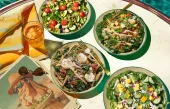
ISSUE OF THE MONTH: Are you looking at co-promoting?
We ask industry analyst Bettina Kurnik of Euromonitor what are the upsides and downsides of these collaborations.
QSR Media: What can it do for a QSR’s business?
Bettina: Given today’s value-conscious consumers, who look to maximise quality across a range of experiences and foodservice formats, co-branding and co-promotions can provide the versatility necessary in the marketplace. In many major markets globally it was versatility, rather than rock-bottom prices, that emerged as the key driver in 2011, and Australia was no exception. The most successful QSR operators were those who were able to steadily expand the range of occasions they serve, and co-branding/co-promotions provide ample opportunity to incorporate borrowed equities and brand imagery to enhance the delivery of benefits against consumer needs for particular dayparts, occasions and/or locations.
QSR Media: What should a QSR think about when deciding to co-brand?
Bettina: The first big question would have to be: how? Companies with a multi-brand presence have the advantage of utilising existing synergies within their brand portfolio. Franchised Food Company (FFCo) and Pacific Retail Management are two such examples: FFCo launched its dual branding efforts in 2010 through a joint Cold Rock/Pretzel World outlet in Hobart and Cold Rock Express stores within select Souvlakihut/Souv Hut sites; and Pacific Retail Management is currently exploring the possibilities offered by the “Back-2-Back” store model for its Go Sushi and Kick Juice brands.
Other operators can consider co-promotions through location or menu inclusions. Pizza operators such as Eagle Boys, Domino’s and Crust have been quick to work with the opportunities provided by location by adopting express-format stores in cinemas, sporting stadiums and amusement parks, thus extending pizza dayparts and occasions.
Co-branding within menus is all about capitalising on a QSR’s strengths in its primary category, with alternate brands considered for its secondary offerings. For instance, a burger fast food QSR could contemplate co-branding with a more established retail or foodservice player for its dessert or drinks menu. With stronger affiliation to the branded product, there is more inclination for the consumer to extend their purchase and thus the co-branding drives up-sell through recognition and desirability. Co-branding can also be incorporated as an opportunity to encourage users of one brand to trial the adjacent brand.
However, as individual brand equities connote different aspects, such as health, fun, contemporary or premium, it all depends on relevance to the target audience when borrowing the equity of dominant brands to successfully premiumise or enhance the theme of an offering.
QSR Media: Will we be seeing more of this in the future?
Bettina: We will certainly be seeing more of this in the future. The benefits of dual-branded ventures, for instance, include potential revenue from two stores and savings in rent, labour and supplies achieved through the economies of scale of running the two businesses from one site, which ensure a more attractive offer to franchisees. The diversified foodservice offering in turn appeals to customers, which can drive up-sell within the transaction.
We’re also anticipating that the growing interest in food trucks is likely to encourage further use of the mobile or “pop-up” format as a means of promoting foodservice brands, particularly among those with a strong youth orientation. QSR mobile food vans have previously been used for branding purposes, such as the Grill’d Airstream Van burger promotions in Sydney and Melbourne and its “Burger Love Tour”, but we think we’ll see a lot more of this in the near future, particularly in regards to music festivals as a location, in conjunction with the fast casual trend.
QSR Media: What are some of the downsides with these initiatives?
Bettina: There are limits to the potential of co-branding and QSR operators should be wary of diluting the impact of the initial brand statement. While consumers are receptive to novel new approaches to their foodservice experience, there is a risk of over-saturation, which can in turn be interpreted as a desperate last ditch effort of an operator to stay afloat. Any co-branding/co-promotion effort cannot compromise on the perceived quality of the foodservice offering, especially as the QSR trade moves towards more gourmet or premium positioning through the fast casual trend. There is certainly a balance to be achieved between convenience, location, occasion, price and quality – and while co-branding can provide timely opportunities in this regard, it’s not necessarily a quick-fix solution.























